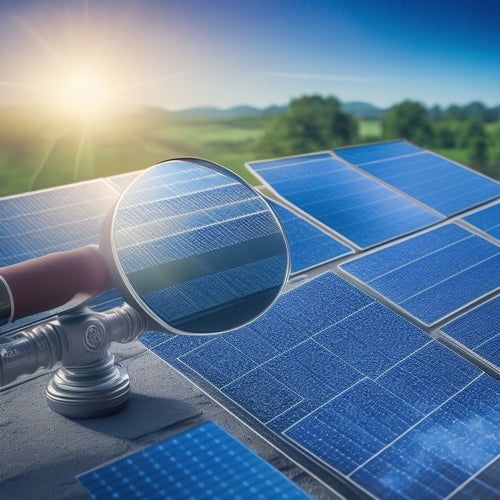
Best Solar Electric Storage Systems for Off-Grid Living
Share
When selecting the best solar electric storage system for off-grid living, you'll want to take into account lithium-ion, lead-acid, and flow batteries, each with their advantages and disadvantages. Assess key metrics like depth of discharge, round-trip efficiency, and lifespan to determine the best fit. Make certain your system includes a compatible solar inverter with energy management capabilities, and look for features like real-time monitoring, scalability, and minimal maintenance. By understanding your daily energy demands and battery capacity needs, you can make an informed decision. Now, explore deeper into the specifics of charging and discharging cycles, and you'll be well on your way to a reliable off-grid energy solution.
Key Takeaways
- When selecting a solar electric storage system, consider lithium-ion batteries for high energy density and long lifespan, or lead-acid for affordability.
- Ensure the system includes a compatible solar inverter with energy management capabilities for efficient energy tracking and optimization.
- Oversize battery capacity by 1-2 times daily energy needs to account for variability, and choose a system with scalable design for future expansion.
- Opt for a system with a high round-trip efficiency (above 95%) and a lifecycle management system to minimize energy losses and prolong battery lifespan.
- Look for a system with real-time monitoring and control capabilities, as well as a comprehensive warranty and support package for optimal performance and cost efficiency.
Top Solar Storage System Options
When it comes to solar electric storage systems, choosing the right storage option is vital to guarantee a seamless and efficient energy supply.
You're likely considering various solar storage system options to find the best fit for your off-grid living needs.
You'll want to investigate solar inverter options that integrate energy management capabilities. This guarantees that your system can optimize energy production, consumption, and storage.
Look for options that offer real-time monitoring and control, enabling you to track your energy usage and make data-driven decisions.
Some top solar storage system options include lithium-ion battery banks, lead-acid batteries, and flow batteries.
Each has its advantages and disadvantages, so it's important to assess factors like depth of discharge, round-trip efficiency, and lifespan.
Key Features to Consider
Frequently, homeowners overlook critical features when selecting a solar electric storage system, which can lead to inefficient energy supply and reduced system lifespan. When choosing a system, you should consider the following key features to guarantee cost efficiency and ideal performance.
| Feature | Description | Importance |
|---|---|---|
| Inverter Compatibility | Guarantees seamless integration with your solar panel system | High |
| Monitoring and Control | Allows real-time tracking and remote monitoring of your system's performance | Medium |
| Scalability | Enables easy expansion of your system as your energy needs grow | Medium |
You should also consider the maintenance requirements of your system. Look for systems with easy-to-replace components and minimal maintenance needs to reduce downtime and extend the lifespan of your system. Additionally, consider the warranty and customer support offered by the manufacturer, as these can considerably impact the overall cost efficiency of your system. By carefully evaluating these features, you can guarantee that your solar electric storage system meets your off-grid living needs.
Battery Capacity and Type
You've carefully evaluated the key features of your solar electric storage system, ensuring seamless integration with your solar panel system and easy expansion as your energy needs grow.
Now, it's time to focus on the battery capacity and type. This critical component determines how much energy your system can store and how efficiently it can be employed.
When selecting a battery, you'll need to take into account the capacity required to meet your daily energy demands. A general rule of thumb is to oversize your battery capacity by 1-2 times your daily energy needs to account for variable weather conditions and unexpected power outages.
Lithium-ion batteries are a popular choice for off-grid living due to their high energy density, long lifespan, and low maintenance requirements. However, they come at a higher upfront cost.
Lead-acid batteries, on the other hand, are more affordable but heavier, bulkier, and require more maintenance. Ultimately, the choice between lithium-ion and lead-acid batteries depends on your budget, energy needs, and personal preferences.
Charging and Discharging Cycles
Battery lifecycle management revolves around charging and discharging cycles, a vital aspect of your solar electric storage system's overall performance and longevity. When you charge and discharge your batteries, you're affecting their overall health and lifespan. A deep discharge can reduce your battery's capacity, while frequent shallow discharges can increase its lifespan.
You need to balance these cycles to optimize your system's performance. Understanding cycle efficiency is essential in this process. It measures how efficiently your battery stores and releases energy. A higher cycle efficiency means your battery can store more energy per cycle, resulting in a longer lifespan.
Look for batteries with high cycle efficiencies, typically above 95%, to minimize energy losses. Conducting a lifespan analysis helps you predict your battery's lifespan based on charging and discharging patterns. This analysis takes into account factors like depth of discharge, charging frequency, and environmental conditions.
Off-Grid System Installation Tips
When designing an off-grid system, proper installation is vital to ascertain seamless integration and best performance. You'll want to verify that every component is carefully selected and installed to maximize energy production and storage.
Start by optimizing your solar panel placement. Consider the direction and angle of your panels to capture the most sunlight throughout the day. Confirm they're securely fastened to your roof or mounting system to withstand harsh weather conditions.
Next, focus on inverter selection. Your inverter should be compatible with your solar panels and battery bank. It's imperative to choose an inverter that can handle the maximum power output of your solar array and charge your batteries efficiently.
Additionally, consider the wiring and electrical connections between components. Use high-quality cables and connectors to minimize energy loss and reduce the risk of electrical faults.
Frequently Asked Questions
Can I Use a Solar Electric Storage System for Grid-Tied Homes?
You can definitely use a solar electric storage system for your grid-tied home, enjoying solar benefits like reduced bills and increased grid independence, while still having the grid as a backup when you need it.
Are Solar Storage Systems Compatible With Wind Power Generation?
You'll be interested to know that 75% of renewable energy systems worldwide combine solar and wind power. Yes, solar storage systems are compatible with wind power generation, enabling wind energy integration through hybrid systems that optimize energy harvesting and storage.
Do I Need a Backup Generator With a Solar Storage System?
You'll need a backup generator if your solar storage system can't meet peak demand or during extended periods of low sunlight, considering generator sizing and system efficiency to guarantee seamless power supply.
Can I Expand My Solar Storage System in the Future?
You can easily expand your solar storage system in the future, thanks to its scalability, allowing you to add more batteries or upgrade to a larger inverter, ensuring you're always powered up and prepared for future upgrades.
Are Solar Storage Systems Compatible With Electric Vehicle Charging?
You'll be pleased to know that most modern solar storage systems are compatible with electric vehicle charging, allowing you to optimize solar charging and maximize energy efficiency, so you can power both your home and vehicle with renewable energy.
Related Posts
-

Why Higher Upfront Costs Are Worth It
You pay a premium for high-quality, energy-efficient products, but they're worth it. With durability testing ensuring...
-

Charging Points in Rural Areas: 5 Key Insights
When driving through rural areas, you'll face a shortage of charging points, making EV ownership stressful and inconv...
-

Solar Panel System Certification Costs: A 10-Point Breakdown
You're looking to understand the costs associated with solar panel system certification. Your total certification cos...


